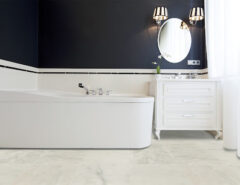At one time, heated floors were a luxury only for high-end homes. Today, more homeowners are turning to the comfort and convenience of radiant heated floors. However, there are benefits and drawbacks to this feature. Keep reading if you’re interested in learning more about the pros and cons of heated floors.
A List of Pros and Cons For Heated Floors
Pro: Clean and Quiet System
While the ductwork in a forced air system is necessary to circulate warm air through your house, that’s not the only thing it spreads around. Dust and bacteria also collect in the ductwork and end up spreading throughout the house when the system is operating. Additionally, there’s no way to quiet the rush of air traveling through the ductwork and out the vents when the system is on.
However, when you warm your house with radiant heated floors, the system is silent, so you don’t have to deal with blowers disturbing your peace. Also, the lack of vents and ductwork means your heating system won’t spread dust and other impurities around your house. For allergy or asthma sufferers, this can mean breathing easier when at home.
Con: Need to Pull Up Floor to Install
Heated floors are part of the infrastructure of your home, so you have to place the heating panels under the floor. As a result, it’s a system that’s nearly impossible to install on floors already installed. If you have new floors or you like your floors so much you would hate to see them ripped up, radiant floor heating might not work for you.
On the other hand, if you’re building a new home or planning on replacing your floors in the near future, this is the ideal opportunity to consider heated floors. Or, if you can use a crawl space or basement to get under the house, you can also consider electric radiant pads that go in between the joists under the subfloor.
Pro: More Efficient Heating
If you’re looking to save money on your heating costs with a more efficient way to warm your house, radiant floor heating might be the answer for you. Simple physics teaches us that warm air rises. Yet when we heat our homes with an HVAC system, we typically pump warm air into the room only for it to make its way to the ceiling immediately, where it does us no good.
Radiant heat warms the air at the floor level where you actually feel it. The system uses little electricity to operate, and since it doesn’t use ductwork to spread warm air around, you’re not losing any to leaks.
Many people use porcelain, ceramic, and natural stone tiles for heated floors because these materials retain the heat for a long time. As a result, they can often turn the heated floors on first thing in the morning, leaving you to enjoy the residual heat from the floor through the rest of the day.
Con: Not Good for Cooling
If you experience a significant number of cold days every year, heated floors might sound like a great option for warming your house. However, it doesn’t work as well if you’re trying to cool your house on warm days. Most radiant systems use a cooling machine connected to the tubing to pump cool air through the floor. This can work in dry climates, but when the humidity starts to go up, this type of system can cause issues. First, condensation can form on the floor and cause it to become very slippery. Second, this moisture can also lead to fungus growth inside your house.
Pro: More Comfortable Heating
When you’re heating your house with a traditional HVAC system, the temperature inside has to drop below a certain temperature before the system will kick on. Once it does, a shot of warm air blasts into the house until the temperature gets back to where you want it. Then the system shuts off and waits to repeat the cycle all over again. This leads to uncomfortable temperature swings inside your house. Yet radiant heat in the floors evenly spreads the warm air throughout the entire room. As a result, no matter where you are in a room, you’ll feel warm and comfortable.
Con: Can Take Time to Heat Up
The size of the room, the type of floor you have, and what insulation you have installed under the floor all play a role in how long it takes to warm up heated floors. A good insulation can increase the amount of warm air that transfers up through the floors and cut down on the amount of time it takes to warm up the floors.
If you have a small room with wood floors, you can expect your floors to heat up between a half hour to an hour. If you have concrete floors or a large room, it could take anywhere from two to eight hours to get to the desired temperature.
Pro: Can Use With a Variety of Floors
Hydronic radiant heat systems use a boiler to circulate hot water through tubes under the floor. Installers will put the tubes in special channels in the subfloor, stapled under the subfloor, or embedded in the concrete slab. Along with the previously mentioned tiles, you can also install carpet, vinyl, or wood on top of this system. However, some installers will recommend installing laminate or engineered wood instead of solid wood if you have high moisture levels in your home. This is because the changes in moisture from heating and cooling could cause hardwood planks to warp or bow.
Con: Hire a Professional to Install
If you’re retrofitting your floors to add radiant heat, unless you’re a seasoned flooring pro–you’ll want to hire a professional contractor to do the job for you. This means the overall cost of the project will be comprised of the product and the labor costs associated with installation. The total product cost itself will vary depending upon how much of the floor and subfloor need to be torn out and reinstalled. The typical cost for a hydronic heating system is around $6-16 a square foot, and the price for electric radiant floor heating ranges from $8-12 a square foot.
If you’re thinking about upgrading to heated floors in your house, you need to consider these pros and cons of heated floors to decide if it’s the right option for your lifestyle.
Resources:
https://blog.builddirect.com/radiant-heating-the-basics/
http://www.realtor.com/advice/home-improvement/pros-cons-radiant-floor-heating/
https://www.proreferral.com/hg/pros-and-cons-radiant-floor-heating-systems/
http://www.houzz.com/ideabooks/18303936/list/warm-up-your-bathroom-with-heated-floors
http://thegreenhome.co.uk/heating-renewables/underfloor-heating/warm-up-underfloor-heating/
https://www.angieslist.com/articles/how-much-does-radiant-floor-heating-cost.htm
http://home.costhelper.com/radiant-floor-heating.html

























